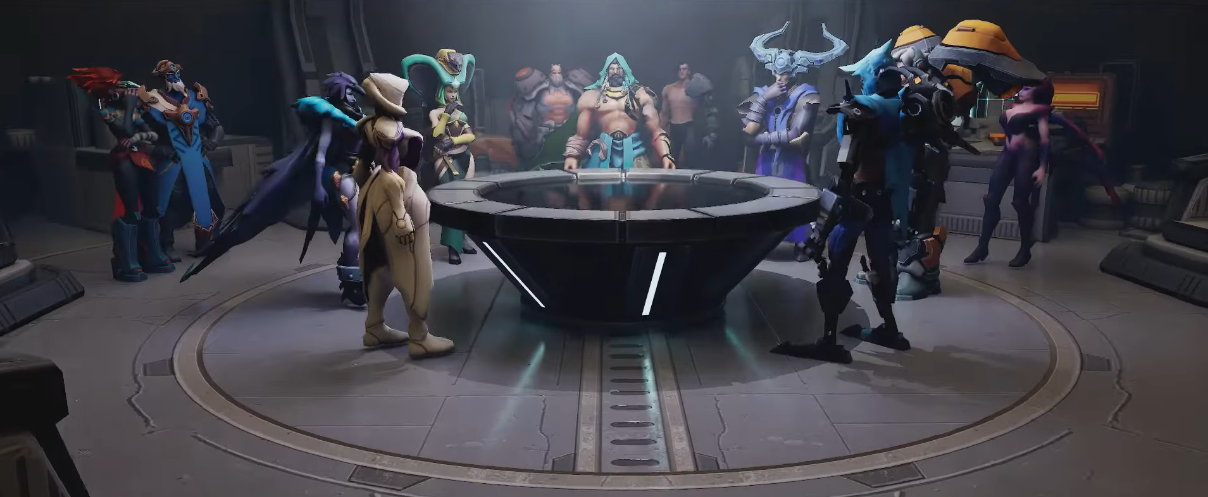Massively multiplayer online games (MMOs) have always been the genre where scale meets ambition. They aim to bring together massive communities of players in persistent virtual worlds that live and breathe beyond any one session. But while the genre has produced juggernauts like World of Warcraft and Final Fantasy XIV, newer MMOs face the monumental challenge of standing out.
Enter Warborne: Above Ashes (Warborne Above Ashes Solarbite), a sci-fi MMO from Taiwan-based developer Pumpkin Studio. On paper, WAA already makes an impression: it promises 100 vs. 100 team battles, six-faction warfare, and a blend of combat and logistical gameplay that allows players to choose their own contribution to the war effort. But what sets it apart from countless other MMO projects floating around Steam? And, more importantly, how does it actually play?
This article takes a closer look at Warborne: Above Ashes—its gameplay systems, inspirations, design philosophy, and why it might just carve out a unique space in the crowded MMO landscape.
First Impressions – A War Built on Scale
The Steam description for WAA wastes no time in highlighting the scale of the game. Six warring factions, each vying for dominance across vast battlefields, provide the backbone for player-driven conflict. Within those conflicts, up to 200 players can clash in 100 vs. 100 battles. That’s already a striking promise, given that few MMOs manage to make large-scale battles feel anything more than chaotic.
But Pumpkin Studio is doing more than just dropping players into a massive warzone. The developers emphasize roles beyond frontline combat. Players can take part in supply runs, logistics, and construction—activities that directly influence the outcome of the war. This is reminiscent of Foxhole, the persistent war MMO where supply chains and player-built infrastructure are as important as bullets fired.
In other words, WAA understands something vital: not every player wants to be a soldier. Some want to be the builder, the tactician, or the unsung hero keeping the army fueled. By giving those playstyles a home, Pumpkin Studio increases both immersion and long-term retention.
The Gameplay Blend – Albion Online Meets League of Legends?
What stands out most about WAA is its unusual approach to moment-to-moment gameplay. Unlike most MMOs, which favor a third-person behind-the-character perspective, WAA is played from an isometric viewpoint. It uses a click-to-move and click-to-attack system—more reminiscent of MOBAs like League of Legends or sandbox MMOs like Albion Online than of traditional MMORPGs.
This design choice has far-reaching implications.
Accessibility – Isometric controls often feel more intuitive for new players, especially those who may be intimidated by the dozens of hotbars and skill rotations common in traditional MMOs.
Clarity in Large Battles – With 200 players fighting simultaneously, an isometric perspective makes it easier to understand positioning, area-of-effect abilities, and the larger ebb and flow of battle.
Strategic Emphasis – The MOBA-style control scheme naturally shifts gameplay towards positioning and tactical decision-making rather than raw mechanical execution.
For players who have bounced off other MMOs because of their steep learning curves, WAA could offer a more approachable alternative while still retaining the depth hardcore fans crave.
Classes, Weapons, and Customization
Pumpkin Studio has teased a wide variety of classes and weapon combinations, though the full roster is still being revealed. The game seems determined to provide enough diversity so that players can craft their own style—whether that means specializing as a frontline bruiser, a stealthy infiltrator, or a logistics-heavy support role.
Weapons appear to play a significant role in shaping identity. Rather than being locked into a rigid class, players can mix and match weapons with skills, creating hybrid builds that adapt to the ever-changing demands of the battlefield. This system borrows a page from Albion Online’s “you are what you wear” philosophy, rewarding experimentation and flexibility rather than forcing players into narrow archetypes.
The key here is freedom. In a war this large, roles need to be fluid. A player who starts the day ferrying supplies may later swap into a combat role to hold the line. WAA seems poised to encourage exactly that kind of adaptability.
Logistics and the Unsung Heroes of War
One of the most intriguing elements of WAA is its inclusion of logistics gameplay. Too often, MMOs reduce warfare to a numbers game: whoever brings the bigger zerg wins. But WAA aims to add more nuance.
Players can:
Build and Repair Structures – From defensive fortifications to supply depots, construction has a tangible impact on the battlefield.
Transport Supplies – Wars are won by armies that are fed and equipped. Moving resources to the front lines ensures that fighters have the tools they need to keep going.
Manage Resources – Some players may take on more behind-the-scenes roles, managing stockpiles and ensuring efficient distribution of weapons and materials.
This creates space for different personalities within the community. The player who doesn’t have the fastest reflexes can still become invaluable by keeping their faction’s supply chain alive. It’s a design philosophy that mirrors Foxhole—a game where wars collapse not because of poor combat, but because logistics fall apart.
Six-Faction Warfare – More Than Two Sides
Most MMOs rely on binary conflict: Alliance vs. Horde, Elyos vs. Asmodians, Order vs. Chaos. WAA instead opts for six competing factions.
This dramatically changes the dynamics of conflict:
Unpredictable Diplomacy – With six factions, alliances, betrayals, and shifting frontlines create a constantly evolving political landscape.
Multiple Fronts – Wars are not fought on a single border. Players may need to defend their own territory while launching opportunistic strikes on weakened neighbors.
Longevity – Binary wars often grow stale as one side pulls ahead. Six factions ensure a level of instability that keeps the meta fresh.
Factional identity also deepens the role-playing element. Players are not just nameless soldiers; they are members of a larger cause, with traditions, culture, and rivalries to lean into.
Comparisons and Inspirations
It’s impossible to talk about WAA without comparing it to its influences.
Foxhole – WAA borrows Foxhole’s emphasis on logistics and persistent warfare. But where Foxhole is top-down and entirely player-driven, WAA blends in more traditional RPG mechanics.
Albion Online – WAA adopts Albion’s isometric combat style and flexible class system, giving players freedom in how they approach battle.
League of Legends – The click-to-move system and combat pacing echo MOBAs, emphasizing clarity, positioning, and teamwork.
EVE Online – The six-faction structure and emphasis on large-scale politics nod towards EVE’s grand strategy, where player alliances shape the universe itself.
What’s exciting is not that WAA imitates these games, but that it weaves their elements together into something distinct. In an industry often criticized for being derivative, Pumpkin Studio is assembling a compelling hybrid.
The Social Layer – Guilds, Communities, and Identity
No MMO survives without a strong social layer, and WAA appears to understand this. Guilds will likely be central to the experience, organizing logistics, planning raids, and leading faction-wide initiatives.
The six-faction structure also means that every player belongs to something larger than themselves. Even solo players, who might just want to gather resources or explore, still contribute to their faction’s overall progress. This sense of shared purpose is a powerful motivator that keeps players logging in.
If Pumpkin Studio can provide the tools for in-game communication, diplomacy, and coordination, WAA could foster the kind of emergent storytelling that makes MMOs legendary.
Challenges Ahead
Ambition is one thing; execution is another. For WAA to succeed, Pumpkin Studio must overcome several hurdles:
Performance in Large Battles – 200-player clashes are exciting on paper but can become a technical nightmare if servers and netcode can’t handle it.
Balance Between Combat and Logistics – If logistics are too tedious, players will ignore them. If they’re too powerful, combat players may feel irrelevant. Finding the right balance is crucial.
New Player Onboarding – Six factions, large-scale warfare, and hybrid systems can be overwhelming. Clear tutorials and progression systems are necessary to avoid scaring off newcomers.
Sustainable Endgame – Many MMOs stumble when players reach “the end.” WAA’s factional warfare must remain engaging in the long term, with evolving goals and meaningful victories.
Pumpkin Studio has set the bar high for itself, and the road ahead will test its ability to deliver on these promises.
Why Warborne: Above Ashes Matters
At its core, Warborne: Above Ashes matters because it is trying something different. In an MMO market dominated by familiar tropes, WAA seeks to merge the accessibility of MOBAs, the sandbox creativity of Albion, and the persistent wars of Foxhole into one coherent package.
It respects the diversity of its player base by offering roles for fighters, builders, and strategists alike. It elevates logistics from background noise to center stage. And it embraces the chaos of six-faction warfare to ensure that no battle is ever predictable.
If Pumpkin Studio succeeds, WAA could become the MMO that finally bridges the gap between large-scale war simulation and accessible, moment-to-moment gameplay.
Final Thoughts
Warborne: Above Ashes is still early in its journey, but the potential is undeniable. Its blend of large-scale warfare, factional politics, logistics gameplay cheap Warborne Above Ashes Solarbite, and isometric combat offers a refreshing take on the MMO formula.
For players tired of MMOs that all feel the same, WAA might just be the breath of fresh air the genre needs. The only question now is whether Pumpkin Studio can deliver on its ambitious vision.
If they can, then Warborne: Above Ashes won’t just be another MMO on Steam—it could be the start of something truly new in the online gaming landscape.






